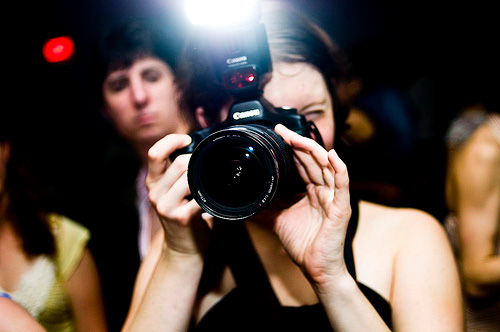If you’ve bought a DSLR hoping to take professional-looking pictures indoors, you’re halfway there. Just remember not to use the built-in flash. You might have also heard that a speedlight (external flash unit) will improve your pictures dramatically. Again, you’re halfway there. The other half of the story is how you use these tools. They’re not miracle machines; you need to use them correctly to get professional-looking results.

“hilary in action” captured by PictureSocial member andre stoeriko
Indoor Flash Techniques (Swivel)
To start with, use a speedlight with a tilt and swivel function. Not one that’s fixed at a certain angle. This is why your built-in flash will not do.
Let’s set the speedlight to TTL mode. TTL stands for “through the lens.” In this mode, your speedlight measures the amount of light coming in through your lens and releases the appropriate amount of flash power when you press the shutter button.
Mount your speedlight on your DSLR, aimed directly at your subject. If your speedlight is pointing directly at your subject, let’s call this the 12 o’clock position. This is possibly the most unflattering position to use your speedlight. It creates harsh shadows if there’s a nearby wall behind your subject and sometimes a flat washed-out look on your subject’s face.
Now position yourself so that there’s a wall on the left or right of your subject (a light-colored or white wall works best). Swivel your speedlight into the 3 o’clock position (if the wall is on your right) or the 9 o’clock position (if the wall is on your left). The speedlight will now be aimed at the nearby wall, while your DSLR is aimed at your subject. This creates a nice side-lighting effect, and is more flattering for your subject.
Let’s now swivel the speedlight to the 6 o’clock position, making sure there’s a wall behind you. This creates a wrap-around light that covers your subject very evenly, eliminating most shadows.
Note: The flash power will be diminished when using the 3 o’clock, 6 o’clock and 9 o’clock positions, so you may need to increase the flash exposure compensation. This is found on your speedlight itself, where you can adjust it so that it shows +1. You can fine-tune it so that the exposure on your subject’s face is correct. The farther the wall is from your speedlight, and the farther the wall is from your subject, the more you’ll need to compensate.
Indoor Flash Techniques (Tilt)
The tilt function is combined with the swivel function to aim your speedlight in exactly the direction that you want. The trick is to aim the speedlight so that it fires at a wall, which will bounce light back onto your subject. We may sometimes wish to aim it at the corner where the wall meets the ceiling. This is to harness the combined surfaces of these two planes and channel the light onto your subject. The goal is to achieve directional light, which means that there is a nice balance of shadow and highlight, due to the light coming from a specific direction.
The larger the light source, the softer the light. This is because a larger light source wraps around your subject and softens the transition between the highlights and the shadows. Our speedlight is inherently a small light source, which produces hard light. In order to get softer light from a small light source, we bounce the light. Since this post discusses on-camera flash, we will not include off-camera flash techniques, which can also be used to produce softer, directional light.
About the Author
Andy Lim (www.simpleslr.info) runs a profitable photography business that spans wedding photography, commercial photography, and photography workshops.
Go to full article: On-Camera TTL Flash Photography Tips
What are your thoughts on this article? Join the discussion on Facebook
PictureCorrect subscribers can also learn more today with our #1 bestseller: The Photography Tutorial eBook
The post On-Camera TTL Flash Photography Tips appeared first on PictureCorrect.
from PictureCorrect https://ift.tt/2tBKnEo
via IFTTT






0 kommenttia:
Lähetä kommentti